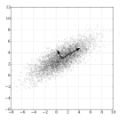We study the problem of sparse tensor principal component analysis: given a tensor $\pmb Y = \pmb W + \lambda x^{\otimes p}$ with $\pmb W \in \otimes^p\mathbb{R}^n$ having i.i.d. Gaussian entries, the goal is to recover the $k$-sparse unit vector $x \in \mathbb{R}^n$. The model captures both sparse PCA (in its Wigner form) and tensor PCA. For the highly sparse regime of $k \leq \sqrt{n}$, we present a family of algorithms that smoothly interpolates between a simple polynomial-time algorithm and the exponential-time exhaustive search algorithm. For any $1 \leq t \leq k$, our algorithms recovers the sparse vector for signal-to-noise ratio $\lambda \geq \tilde{\mathcal{O}} (\sqrt{t} \cdot (k/t)^{p/2})$ in time $\tilde{\mathcal{O}}(n^{p+t})$, capturing the state-of-the-art guarantees for the matrix settings (in both the polynomial-time and sub-exponential time regimes). Our results naturally extend to the case of $r$ distinct $k$-sparse signals with disjoint supports, with guarantees that are independent of the number of spikes. Even in the restricted case of sparse PCA, known algorithms only recover the sparse vectors for $\lambda \geq \tilde{\mathcal{O}}(k \cdot r)$ while our algorithms require $\lambda \geq \tilde{\mathcal{O}}(k)$. Finally, by analyzing the low-degree likelihood ratio, we complement these algorithmic results with rigorous evidence illustrating the trade-offs between signal-to-noise ratio and running time. This lower bound captures the known lower bounds for both sparse PCA and tensor PCA. In this general model, we observe a more intricate three-way trade-off between the number of samples $n$, the sparsity $k$, and the tensor power $p$.
翻译:我们研究的是稀有的沙拉本元素分析问题:考虑到一个 $\ pmb Y =\ pmb W +\ lambda x ⁇ otime p} $\ pb W 在\ otimes\ p\ mathb{R ⁇ 美元有 i.d. 高西亚条目,目标是回收 $k$- sprose 单位矢量 $x \ mathbision{ R ⁇ n$。模型既能捕捉稀有的 CPA (以其 Wigner 形式) 和 ARmor 交易 。对于高度稀薄的 MIRC =leqdal_ lider_ 美元,我们呈现的算盘中顺畅的算数 。对于任何 $leq t\ leq k k$, 我们的算法仅能回收信号到的稀少的矢量量, 以我们的时间 =\\ 美元( r\\\\ laxxx) 时间案例中,(sral\\\\\\\\\\ lax cal cal case axxxxxxxxxxxxxxxxxxxxxxxxxxxxxxxxxxxxxxxxxxxxxxxxxxxxxxxxxxxxxxxxxxxxxxxxxxxxxxxxxxxxxxxxxxxxxxxxxxxxxxxxxxxxxxxxxxxxxxxxxxxxxxxxxxxxxxxxxxxxxxxxxxxxxxx======================================================================================================


